Hyperacuity may refer to:
| This disambiguation page lists articles associated with the title Hyperacuity. If an internal link led you here, you may wish to change the link to point directly to the intended article. |
Hyperacuity may refer to:
| This disambiguation page lists articles associated with the title Hyperacuity. If an internal link led you here, you may wish to change the link to point directly to the intended article. |

Telepathy is the purported vicarious transmission of information from one person to another without using any known human sensory channels or physical interaction. The term was coined in 1882 by the classical scholar Frederic W. H. Myers, a founder of the Society for Psychical Research (SPR), and has remained more popular than the earlier expression thought-transference.

Karl Ewald Konstantin Hering was a German physiologist who did much research into color vision, binocular perception and eye movements. He proposed opponent color theory in 1892.

A vernier scale is a visual aid to take an accurate measurement reading between two graduation markings on a linear scale by using mechanical interpolation; thereby increasing resolution and reducing measurement uncertainty by using Vernier acuity to reduce human estimation error.

Gregory Howe is an American guitarist and composer. An active musician for more than three decades, he has released nine studio albums in addition to collaborating with a wide variety of artists.

Visual acuity (VA) commonly refers to the clarity of vision. Visual acuity is dependent on optical and neural factors, i.e., (i) the sharpness of the retinal focus within the eye, (ii) the health and functioning of the retina, and (iii) the sensitivity of the interpretative faculty of the brain.

Macular degeneration, also known as age-related macular degeneration, is a medical condition which may result in blurred or no vision in the center of the visual field. Early on there are often no symptoms. Over time, however, some people experience a gradual worsening of vision that may affect one or both eyes. While it does not result in complete blindness, loss of central vision can make it hard to recognize faces, drive, read, or perform other activities of daily life. Visual hallucinations may also occur but these do not represent a mental illness.

George Gilbert Aimé Murray was an Australian-born British classical scholar and public intellectual, with connections in many spheres. He was an outstanding scholar of the language and culture of Ancient Greece, perhaps the leading authority in the first half of the twentieth century. He is the basis for the character of Adolphus Cusins in his friend George Bernard Shaw's play Major Barbara, and also appears as the chorus figure in Tony Harrison's play Fram.
Super-resolution imaging (SR) is a class of techniques that enhance (increase) the resolution of an imaging system. In optical SR the diffraction limit of systems is transcended, while in geometrical SR the resolution of digital imaging sensors is enhanced.
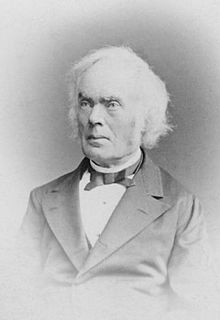
Alfred Wilhelm Volkmann was a German physiologist, anatomist, and philosopher. He specialized in the study of the nervous and optic systems.
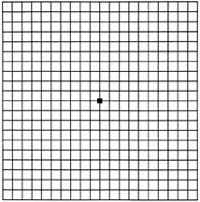
The Amsler grid, used since 1945, is a grid of horizontal and vertical lines used to monitor a person's central visual field. The grid was developed by Marc Amsler, a Swiss ophthalmologist. It is a diagnostic tool that aids in the detection of visual disturbances caused by changes in the retina, particularly the macula, as well as the optic nerve and the visual pathway to the brain.
A perceptual paradox illustrates the failure of a theoretical prediction. Theories of perception are supposed to help a researcher predict what will be perceived when senses are stimulated.
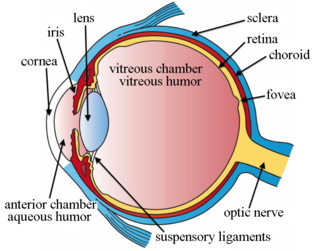
Choroidal neovascularization (CNV) is the creation of new blood vessels in the choroid layer of the eye. Choroidal neovascularization is a common cause of neovascular degenerative maculopathy commonly exacerbated by extreme myopia, malignant myopic degeneration, or age-related developments.
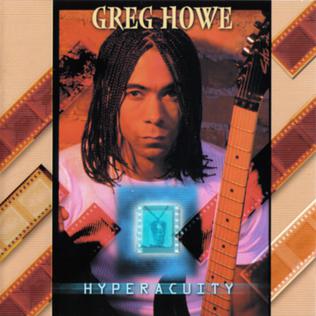
Hyperacuity is the seventh studio album by guitarist Greg Howe, released on June 6, 2000 through Tone Center Records.

Optimum HDTV viewing distance is the distance that provides the viewer with the optimum immersive visual HDTV experience.
Perceptual learning is learning better perception skills such as differentiating two musical tones from one another or categorizations of spatial and temporal patterns relevant to real-world expertise as in reading, seeing relations among chess pieces, knowing whether or not an X-ray image shows a tumor.
Preferential hyperacuity perimetry (PHP) is a psychophysical test used to identify and quantify visual abnormalities such as metamorphopsia and scotoma. It is a type of perimetry.
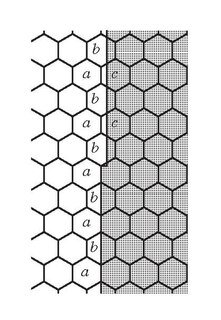
The sharpness of our senses is defined by the finest detail we can discriminate. Visual acuity is measured by the smallest letters that can be distinguished on a chart and is governed by the anatomical spacing of the mosaic of sensory elements on the retina. Yet spatial distinctions can be made on a finer scale still: misalignment of borders can be detected with a precision up to 10 times better than visual acuity, as already shown by Ewald Hering in 1899. This hyperacuity, transcending by far the size limits set by the retinal 'pixels', depends on sophisticated information processing in the brain.
Stereoscopic acuity, also stereoacuity, is the smallest detectable depth difference that can be seen in binocular vision.

Gerald Westheimer AM FRS is an Australian scientist at University of California, Berkeley researching the eye, its optics, and how we see details in space and in three dimensions.

Vernier acuity is a type of visual acuity – more precisely of hyperacuity – that measures the ability to discern a disalignment among two line segments or gratings. A subject's vernier acuity is the smallest visible offset between the stimuli that can be detected. Because the disalignments are often much smaller than the diameter and spacing of retinal receptors, vernier acuity requires neural processing and "pooling" to detect it. Because vernier acuity exceeds acuity by far, the phenomenon has been termed hyperacuity. Vernier acuity develops rapidly during infancy and continues to slowly develop throughout childhood. At approximately three to twelve months old, it surpasses grating acuity in foveal vision in humans. However, vernier acuity decreases more quickly than grating acuity in peripheral vision. Vernier acuity was first explained by Ewald Hering in 1899, based on earlier data by Alfred Volkmann in 1863 and results by Ernst Anton Wülfing in 1892.